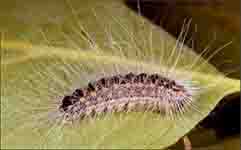Experiences with
|
Treatment date: |
June 8, 2010 |
Plant: |
Cherry trees |
Location: |
Garden |
Problem: |
Infestation of winter moth |
Analysis: |
|
Treatment: |
Watered with a solution of 10 ml in 10 L water |
Result: |
June 12: new leaves forming at the tips; no new infestation |
| June 27: new shoots not affected |
 |
 |
| Before | Cherry trees (sour cherry) no further infestation |
 |
 |
| Cherry trees (sweet cherry) no further infestation |
Cherry trees (sweet cherry) no further infestation |
Bombyx 6X: Oak Processionary Treated with Homeopathy
The caterpillar of the
Oak Processionary Moth, which are often found in large numbers on oak trees,
develop long poisonous hairs with bristles containing nettle toxin. These hairs
easily break and can often be carried far on the wind. On contact with the skin,
they cause inflammation and reactions similar to an insect bite.
Ms
Giselle S. sent us the following report on her experience with the homeopathic
preparation Bombyx
proc.6X, made from the caterpillar of the oak processionary
moth.
About 3 weeks ago (early June) I bought the remedy Bombyx proc. 6 X
from you. Following the description, I treated 10 trees with it – 10 ml in 10
litres of water, 2 watering cans per tree in the root area. It's only a drop in
the ocean since there are approximately 100 trees on the piece of land, but I
wanted to first see the effect for myself.
After about a week, the
caterpillars began to avoid the treated trees, no longer climbing onto them. Two
weeks after the first application, this behaviour became more obvious:
caterpillars that were thrown off by the wind and weather no longer climbed back
onto the trees, and other groups marched back down off the tree they were on.
They just no longer seemed to like the taste of the leaves. In the meantime I
watered the trees again with the remedy.
The caterpillars do not seem to be
harmed by the treatment but they simply go elsewhere to find other host plants,
such as a nearby birch. Like the German saying that old things are no longer
tasty but we will not starve for that reason. So do we have to water all the
plants and trees in this area in order to starve them?! I did not see this
migration with trees that were not treated.






